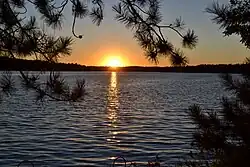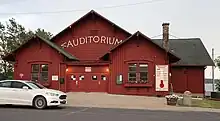Lake Nebagamon, Wisconsin | |
|---|---|
 Sunset in Lake Nebagamon | |
 Location of Lake Nebagamon in Douglas County, Wisconsin. | |
| Coordinates: 46°30′46″N 91°42′1″W / 46.51278°N 91.70028°W | |
| Country | |
| State | |
| County | Douglas |
| Area | |
| • Total | 14.26 sq mi (36.94 km2) |
| • Land | 12.52 sq mi (32.43 km2) |
| • Water | 1.74 sq mi (4.51 km2) |
| Elevation | 1,152 ft (351 m) |
| Population | |
| • Total | 1,123 |
| • Estimate (2022)[4] | 1,130 |
| • Density | 83.77/sq mi (32.35/km2) |
| Time zone | UTC-6 (Central (CST)) |
| • Summer (DST) | UTC-5 (CDT) |
| Area code(s) | 715 and 534 |
| FIPS code | 55-41725[5] |
| GNIS feature ID | 1567743[2] |
| Website | www.villagelakenebagamon.com |
Lake Nebagamon is a village in Douglas County, Wisconsin, United States. The population was 1,069 at the 2010 census.
Transportation
U.S. Highway 2, U.S. Highway 53, and Wisconsin Highway 27 are located in the Lake Nebagamon area. County Road F, County Road P, and County Road B are three of the main routes in the community.
History
The name Nebagamon is derived from the Chippewa Indian phrase "Nee-bay-go-moh-win", translated as "place to hunt deer by fire on the water." The journals and maps of French explorer Joseph Nicollet, however, suggest that this could be a mistake in translation. It is chronicled on Wednesday, August 9, 1837, by Nicollet, that Nibegomowin Creek (Now Nebagamon Creek, sharing its name with the lake) was, at the time, referred to as Sleeping Bear River. Nibegomowin more closely translates to night-time game waiting and could possibly be a place where game, such as bear, rested or were tracked in the night. Sleeping Bear River (Nebagamon Creek) can be seen on Nicollet’s 1843 map, Hydrographical Basin of the Upper Mississippi River.
Geography
Lake Nebagamon is located at 46°30′46″N 91°42′1″W / 46.51278°N 91.70028°W (46.512894, -91.700351).[6] According to the United States Census Bureau, the village has a total area of 14.34 square miles (37.14 km2), of which, 12.60 square miles (32.63 km2) of it is land and 1.74 square miles (4.51 km2) is water.[7]
Lake Nebagamon is located 26 miles east of the city of Superior.
Demographics
| Census | Pop. | Note | %± |
|---|---|---|---|
| 1910 | 483 | — | |
| 1920 | 458 | −5.2% | |
| 1930 | 367 | −19.9% | |
| 1940 | 357 | −2.7% | |
| 1950 | 340 | −4.8% | |
| 1960 | 346 | 1.8% | |
| 1970 | 523 | 51.2% | |
| 1980 | 780 | 49.1% | |
| 1990 | 900 | 15.4% | |
| 2000 | 1,015 | 12.8% | |
| 2010 | 1,069 | 5.3% | |
| 2020 | 1,123 | 5.1% | |
| 2022 (est.) | 1,130 | [4] | 0.6% |
| U.S. Decennial Census[8] | |||
2010 census
As of the census[3] of 2010, there were 1,069 people, 446 households, and 321 families living in the village. The population density was 84.8 inhabitants per square mile (32.7/km2). There were 775 housing units at an average density of 61.5 per square mile (23.7/km2). The racial makeup of the village was 95.9% White, 0.4% African American, 0.3% Native American, 0.9% Asian, 0.6% from other races, and 2.0% from two or more races. Hispanic or Latino of any race were 0.7% of the population.
There were 446 households, of which 28.7% had children under the age of 18 living with them, 60.8% were married couples living together, 5.6% had a female householder with no husband present, 5.6% had a male householder with no wife present, and 28.0% were non-families. 21.3% of all households were made up of individuals, and 7% had someone living alone who was 65 years of age or older. The average household size was 2.40 and the average family size was 2.75.
The median age in the village was 47.5 years. 22.2% of residents were under the age of 18; 4.7% were between the ages of 18 and 24; 19.4% were from 25 to 44; 38.7% were from 45 to 64; and 14.9% were 65 years of age or older. The gender makeup of the village was 52.5% male and 47.5% female.
2000 census
As of the census[5] of 2000, there were 1,015 people, 428 households, and 294 families living in the village. The population density was 80.2 people per square mile (31.0/km2). There were 746 housing units at an average density of 58.9 per square mile (22.8/km2). The racial makeup of the village was 98.52% White, 0.20% African American, 0.69% Native American, 0.10% Asian, 0.30% from other races, and 0.20% from two or more races. Hispanic or Latino of any race were 0.79% of the population.
There were 428 households, out of which 29.9% had children under the age of 18 living with them, 59.3% were married couples living together, 6.3% had a female householder with no husband present, and 31.1% were non-families. 27.6% of all households were made up of individuals, and 12.9% had someone living alone who was 65 years of age or older. The average household size was 2.37 and the average family size was 2.85.
In the village, the population was spread out, with 25.5% under the age of 18, 4.0% from 18 to 24, 26.1% from 25 to 44, 29.5% from 45 to 64, and 14.9% who were 65 years of age or older. The median age was 42 years. For every 100 females, there were 103.8 males. For every 100 females age 18 and over, there were 104.3 males.
The median income for a household in the village was $48,333, and the median income for a family was $59,792. Males had a median income of $41,302 versus $30,156 for females. The per capita income for the village was $23,665. About 2.1% of families and 5.1% of the population were below the poverty line, including 6.0% of those under age 18 and 4.2% of those age 65 or over.
Recreation
The village is the home of Camp Nebagamon, a boys' overnight camp founded in 1929. The camp is located on property originally owned by Weyerhauser Paper Company.[9]
Culture

Lake Nebagamon is one of the places claiming to be the home of the world's heaviest ball of twine.[10][11]
Each year in early July, the town hosts a 5-mile run, known as the "Dragin' Tail Run." Starting at the town's Dairy Queen, the run allows contestants to see the entire town, which consists of Camp Nebagamon, a lake that serves as the town's namesake, Patti's Dockside Bar and Grill, Bridge's Indianhead Tavern, Sharon's Café, Lawn Beach Supper Club, Midland Market, the Imogene McGrath Memorial Library, three churches that the town houses, and the Historic Lakefront Auditorium. Participants receive a T-shirt depicting a fireman using a dragon's tail as a fire hose, representing the Lake Nebagamon Fire Dept.'s heavy sponsorship of the event. The 2009 race was held on July 4. The winner finished in 26 minutes, 52 seconds, at a 5:22 mile pace.
Notable people
References
- ↑ "2019 U.S. Gazetteer Files". United States Census Bureau. Retrieved August 7, 2020.
- 1 2 "US Board on Geographic Names". United States Geological Survey. October 25, 2007. Retrieved January 31, 2008.
- 1 2 "U.S. Census website". United States Census Bureau. Retrieved November 18, 2012.
- 1 2 "Population and Housing Unit Estimates". United States Census Bureau. May 24, 2020. Retrieved May 27, 2020.
- 1 2 "U.S. Census website". United States Census Bureau. Retrieved January 31, 2008.
- ↑ "US Gazetteer files: 2010, 2000, and 1990". United States Census Bureau. February 12, 2011. Retrieved April 23, 2011.
- ↑ "US Gazetteer files 2010". United States Census Bureau. Archived from the original on January 25, 2012. Retrieved November 18, 2012.
- ↑ "Census of Population and Housing". Census.gov. Retrieved June 4, 2015.
- ↑ Stein, Sally (2009). Keeping the Fires Burning: A History and Memoir of Camp Nebagamon. St. Louis: Left Bank Books. ISBN 978-0-692-00355-8.
- ↑ "JFK's World's Largest Ball of Twine". RoadsideAmerica.com.
- ↑ Tim Hwang. "Twisted: The Battle to Be the World's Largest Ball of Twine". The Atlantic.
